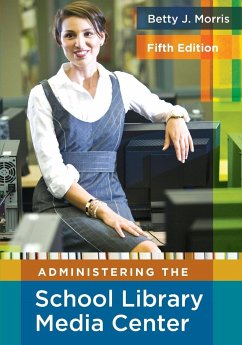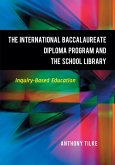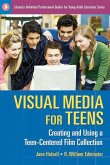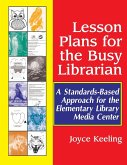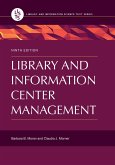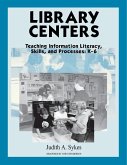Betty J. Morris
Administering the School Library Media Center
Betty J. Morris
Administering the School Library Media Center
- Broschiertes Buch
- Merkliste
- Auf die Merkliste
- Bewerten Bewerten
- Teilen
- Produkt teilen
- Produkterinnerung
- Produkterinnerung
This is the most comprehensive textbook on school library administration available, now updated to include the latest standards and address new technologies.
Andere Kunden interessierten sich auch für
![Re-Designing the High School Library for the Forgotten Half Re-Designing the High School Library for the Forgotten Half]() Margie J. Klink ThomasRe-Designing the High School Library for the Forgotten Half49,99 €
Margie J. Klink ThomasRe-Designing the High School Library for the Forgotten Half49,99 €![The International Baccalaureate Diploma Program and the School Library The International Baccalaureate Diploma Program and the School Library]() Anthony TilkeThe International Baccalaureate Diploma Program and the School Library49,99 €
Anthony TilkeThe International Baccalaureate Diploma Program and the School Library49,99 €![Visual Media for Teens Visual Media for Teens]() Jane HalsallVisual Media for Teens51,99 €
Jane HalsallVisual Media for Teens51,99 €![Lesson Plans for the Busy Librarian Lesson Plans for the Busy Librarian]() Joyce KeelingLesson Plans for the Busy Librarian42,99 €
Joyce KeelingLesson Plans for the Busy Librarian42,99 €![The Responsive Public Library The Responsive Public Library]() Sharon L. BakerThe Responsive Public Library56,99 €
Sharon L. BakerThe Responsive Public Library56,99 €![Library and Information Center Management Library and Information Center Management]() Barbara B. MoranLibrary and Information Center Management66,99 €
Barbara B. MoranLibrary and Information Center Management66,99 €![Library Centers Library Centers]() Judith Anne SykesLibrary Centers45,99 €
Judith Anne SykesLibrary Centers45,99 €-
-
-
This is the most comprehensive textbook on school library administration available, now updated to include the latest standards and address new technologies.
Produktdetails
- Produktdetails
- Verlag: Bloomsbury Publishing Plc
- 5 Revised edition
- Seitenzahl: 600
- Erscheinungstermin: 16. August 2010
- Englisch
- Abmessung: 254mm x 178mm x 32mm
- Gewicht: 1122g
- ISBN-13: 9781591586890
- ISBN-10: 1591586895
- Artikelnr.: 31383001
- Herstellerkennzeichnung
- Libri GmbH
- Europaallee 1
- 36244 Bad Hersfeld
- gpsr@libri.de
- Verlag: Bloomsbury Publishing Plc
- 5 Revised edition
- Seitenzahl: 600
- Erscheinungstermin: 16. August 2010
- Englisch
- Abmessung: 254mm x 178mm x 32mm
- Gewicht: 1122g
- ISBN-13: 9781591586890
- ISBN-10: 1591586895
- Artikelnr.: 31383001
- Herstellerkennzeichnung
- Libri GmbH
- Europaallee 1
- 36244 Bad Hersfeld
- gpsr@libri.de
Betty J. Morris, PhD, is professor and chair of the library media program of the Department of Educational Resources, Jacksonville State University, Jacksonville, AL.
Exhibits Preface Acknowledgments Chapter 1 School Library: A Historical
Perspective1 Introduction The Era of the School District Library The
Genesis of the School Library The Age of Development The Emergence of the
Media Center Chapter 2 Forging Proactive Leadership and Partnershipin Media
Centers Proactive Leadership Roles of the School Library Media Specialist
Partnerships within the School Constituency Links of Communication within
and Outside the School School Library Media Specialist as a Change Agent
and Program Administrator Chapter 3 Functions of the School Library Media
Center Services Functions Related to User Activities Converting a School
Library Media Center into a Virtual Library Future School Library Media
Programs Chapter 4 Developing a School Library Media Center Program The
School Library Media Specialist and the Curriculum The Instructional
Program Instructional Components Publicizing the School Library Media
Center Hours of Service, Attendance, and Use of the OPAC Chapter 5 The
Media Center Budget Introduction Sources of Funding The Big Budget Picture
Budget Levels of Funding Budgeting Systems Creating the School Library
Media Center Budget Accounting for the Media Center's Money Conclusion
Chapter 6 Staff Managerial Principles Personnel Categories How Big a Staff?
Representative Center Tasks Job Descriptions Certification National
Certification Standards Recruitment and Selection Staff Training
Supervision (Staff Evaluation) Manuals The Future of School Library Media
Centers Chapter 7 Facilities Planning Space Facilities for Major Functions
Floor Plan Web Sites Environmental Elements Furnishings Facilities for
Special Media Services Chapter 8 Media Selection: Policies and Procedures
Background Knowledge Organizing the Media Selection Program Writing a Media
Selection Policy Standards Selection Aids Practical Points to Aid Selection
Censorship and the School Library Media Center Chapter 9 Media Selection:
Criteria and Selection Aids Quantitative Criteria for Educational Materials
and Equipment General Criteria for Selecting Educational Materials
Selection Criteria for Slow or Reluctant Learners Specific Criteria for
Selecting Educational Materials General Criteria for Selecting Audiovisual
Equipment Specific Criteria for Selecting Audiovisual Equipment Selection
Aids for Educational Materials General Audiovisual Sources Chapter 10
Technology: The Crucial Link Introduction Top 10 Things Technology Leaders
Do Technology Advice for 21st-Century Library Media Specialists The Virtual
Library Technology Planning Preparing the School for Technology Technology
and Student Learning Technology Management New Technology Innovations
Creating a School Library Media Center Web Page Standards and Their Impact
on Technology Automation and the Internet Internet Resource Sites and
Technology Journals Chapter 11 Acquisition and Organization Bidding
Purchasing Order Processing Classification and Cataloging Local Production
of Materials Copyright and the School Library Media Center Chapter 12
Practical Aspects of Program Administration Changes in Technology
Circulation Procedures Inventory and Weeding Procedures Maintaining the
Collection Records and Reports Web Pages Managing a Book Fair Chapter 13
Outside the Walls of the School Library Media Center Associations Federal
and State Agencies and Programs School Library Media Centers and the Public
Library School Library Media Centers and Networking School Library Media
Specialist Reading Shelf Chapter 14 Evaluation The School Library Media
Specialist's Evaluation of the Media Program Building-Level Media Program
Evaluation Staff Evaluation Evaluation by School Library Media Center Users
Appendix I State Directory of School Library Media Center Agencies
Appendix II Directory of Associations and Agencies Appendix III Directory
of Selected Library Furniture and Supply Houses Appendix IV Key Documents
from American Library Association Web Sites Association for Educational
Communications and Technology (AECT) Code of Ethics Citizen's Request Form
for Reevaluation of Media Center Materials Index
Perspective1 Introduction The Era of the School District Library The
Genesis of the School Library The Age of Development The Emergence of the
Media Center Chapter 2 Forging Proactive Leadership and Partnershipin Media
Centers Proactive Leadership Roles of the School Library Media Specialist
Partnerships within the School Constituency Links of Communication within
and Outside the School School Library Media Specialist as a Change Agent
and Program Administrator Chapter 3 Functions of the School Library Media
Center Services Functions Related to User Activities Converting a School
Library Media Center into a Virtual Library Future School Library Media
Programs Chapter 4 Developing a School Library Media Center Program The
School Library Media Specialist and the Curriculum The Instructional
Program Instructional Components Publicizing the School Library Media
Center Hours of Service, Attendance, and Use of the OPAC Chapter 5 The
Media Center Budget Introduction Sources of Funding The Big Budget Picture
Budget Levels of Funding Budgeting Systems Creating the School Library
Media Center Budget Accounting for the Media Center's Money Conclusion
Chapter 6 Staff Managerial Principles Personnel Categories How Big a Staff?
Representative Center Tasks Job Descriptions Certification National
Certification Standards Recruitment and Selection Staff Training
Supervision (Staff Evaluation) Manuals The Future of School Library Media
Centers Chapter 7 Facilities Planning Space Facilities for Major Functions
Floor Plan Web Sites Environmental Elements Furnishings Facilities for
Special Media Services Chapter 8 Media Selection: Policies and Procedures
Background Knowledge Organizing the Media Selection Program Writing a Media
Selection Policy Standards Selection Aids Practical Points to Aid Selection
Censorship and the School Library Media Center Chapter 9 Media Selection:
Criteria and Selection Aids Quantitative Criteria for Educational Materials
and Equipment General Criteria for Selecting Educational Materials
Selection Criteria for Slow or Reluctant Learners Specific Criteria for
Selecting Educational Materials General Criteria for Selecting Audiovisual
Equipment Specific Criteria for Selecting Audiovisual Equipment Selection
Aids for Educational Materials General Audiovisual Sources Chapter 10
Technology: The Crucial Link Introduction Top 10 Things Technology Leaders
Do Technology Advice for 21st-Century Library Media Specialists The Virtual
Library Technology Planning Preparing the School for Technology Technology
and Student Learning Technology Management New Technology Innovations
Creating a School Library Media Center Web Page Standards and Their Impact
on Technology Automation and the Internet Internet Resource Sites and
Technology Journals Chapter 11 Acquisition and Organization Bidding
Purchasing Order Processing Classification and Cataloging Local Production
of Materials Copyright and the School Library Media Center Chapter 12
Practical Aspects of Program Administration Changes in Technology
Circulation Procedures Inventory and Weeding Procedures Maintaining the
Collection Records and Reports Web Pages Managing a Book Fair Chapter 13
Outside the Walls of the School Library Media Center Associations Federal
and State Agencies and Programs School Library Media Centers and the Public
Library School Library Media Centers and Networking School Library Media
Specialist Reading Shelf Chapter 14 Evaluation The School Library Media
Specialist's Evaluation of the Media Program Building-Level Media Program
Evaluation Staff Evaluation Evaluation by School Library Media Center Users
Appendix I State Directory of School Library Media Center Agencies
Appendix II Directory of Associations and Agencies Appendix III Directory
of Selected Library Furniture and Supply Houses Appendix IV Key Documents
from American Library Association Web Sites Association for Educational
Communications and Technology (AECT) Code of Ethics Citizen's Request Form
for Reevaluation of Media Center Materials Index
Exhibits Preface Acknowledgments Chapter 1 School Library: A Historical
Perspective1 Introduction The Era of the School District Library The
Genesis of the School Library The Age of Development The Emergence of the
Media Center Chapter 2 Forging Proactive Leadership and Partnershipin Media
Centers Proactive Leadership Roles of the School Library Media Specialist
Partnerships within the School Constituency Links of Communication within
and Outside the School School Library Media Specialist as a Change Agent
and Program Administrator Chapter 3 Functions of the School Library Media
Center Services Functions Related to User Activities Converting a School
Library Media Center into a Virtual Library Future School Library Media
Programs Chapter 4 Developing a School Library Media Center Program The
School Library Media Specialist and the Curriculum The Instructional
Program Instructional Components Publicizing the School Library Media
Center Hours of Service, Attendance, and Use of the OPAC Chapter 5 The
Media Center Budget Introduction Sources of Funding The Big Budget Picture
Budget Levels of Funding Budgeting Systems Creating the School Library
Media Center Budget Accounting for the Media Center's Money Conclusion
Chapter 6 Staff Managerial Principles Personnel Categories How Big a Staff?
Representative Center Tasks Job Descriptions Certification National
Certification Standards Recruitment and Selection Staff Training
Supervision (Staff Evaluation) Manuals The Future of School Library Media
Centers Chapter 7 Facilities Planning Space Facilities for Major Functions
Floor Plan Web Sites Environmental Elements Furnishings Facilities for
Special Media Services Chapter 8 Media Selection: Policies and Procedures
Background Knowledge Organizing the Media Selection Program Writing a Media
Selection Policy Standards Selection Aids Practical Points to Aid Selection
Censorship and the School Library Media Center Chapter 9 Media Selection:
Criteria and Selection Aids Quantitative Criteria for Educational Materials
and Equipment General Criteria for Selecting Educational Materials
Selection Criteria for Slow or Reluctant Learners Specific Criteria for
Selecting Educational Materials General Criteria for Selecting Audiovisual
Equipment Specific Criteria for Selecting Audiovisual Equipment Selection
Aids for Educational Materials General Audiovisual Sources Chapter 10
Technology: The Crucial Link Introduction Top 10 Things Technology Leaders
Do Technology Advice for 21st-Century Library Media Specialists The Virtual
Library Technology Planning Preparing the School for Technology Technology
and Student Learning Technology Management New Technology Innovations
Creating a School Library Media Center Web Page Standards and Their Impact
on Technology Automation and the Internet Internet Resource Sites and
Technology Journals Chapter 11 Acquisition and Organization Bidding
Purchasing Order Processing Classification and Cataloging Local Production
of Materials Copyright and the School Library Media Center Chapter 12
Practical Aspects of Program Administration Changes in Technology
Circulation Procedures Inventory and Weeding Procedures Maintaining the
Collection Records and Reports Web Pages Managing a Book Fair Chapter 13
Outside the Walls of the School Library Media Center Associations Federal
and State Agencies and Programs School Library Media Centers and the Public
Library School Library Media Centers and Networking School Library Media
Specialist Reading Shelf Chapter 14 Evaluation The School Library Media
Specialist's Evaluation of the Media Program Building-Level Media Program
Evaluation Staff Evaluation Evaluation by School Library Media Center Users
Appendix I State Directory of School Library Media Center Agencies
Appendix II Directory of Associations and Agencies Appendix III Directory
of Selected Library Furniture and Supply Houses Appendix IV Key Documents
from American Library Association Web Sites Association for Educational
Communications and Technology (AECT) Code of Ethics Citizen's Request Form
for Reevaluation of Media Center Materials Index
Perspective1 Introduction The Era of the School District Library The
Genesis of the School Library The Age of Development The Emergence of the
Media Center Chapter 2 Forging Proactive Leadership and Partnershipin Media
Centers Proactive Leadership Roles of the School Library Media Specialist
Partnerships within the School Constituency Links of Communication within
and Outside the School School Library Media Specialist as a Change Agent
and Program Administrator Chapter 3 Functions of the School Library Media
Center Services Functions Related to User Activities Converting a School
Library Media Center into a Virtual Library Future School Library Media
Programs Chapter 4 Developing a School Library Media Center Program The
School Library Media Specialist and the Curriculum The Instructional
Program Instructional Components Publicizing the School Library Media
Center Hours of Service, Attendance, and Use of the OPAC Chapter 5 The
Media Center Budget Introduction Sources of Funding The Big Budget Picture
Budget Levels of Funding Budgeting Systems Creating the School Library
Media Center Budget Accounting for the Media Center's Money Conclusion
Chapter 6 Staff Managerial Principles Personnel Categories How Big a Staff?
Representative Center Tasks Job Descriptions Certification National
Certification Standards Recruitment and Selection Staff Training
Supervision (Staff Evaluation) Manuals The Future of School Library Media
Centers Chapter 7 Facilities Planning Space Facilities for Major Functions
Floor Plan Web Sites Environmental Elements Furnishings Facilities for
Special Media Services Chapter 8 Media Selection: Policies and Procedures
Background Knowledge Organizing the Media Selection Program Writing a Media
Selection Policy Standards Selection Aids Practical Points to Aid Selection
Censorship and the School Library Media Center Chapter 9 Media Selection:
Criteria and Selection Aids Quantitative Criteria for Educational Materials
and Equipment General Criteria for Selecting Educational Materials
Selection Criteria for Slow or Reluctant Learners Specific Criteria for
Selecting Educational Materials General Criteria for Selecting Audiovisual
Equipment Specific Criteria for Selecting Audiovisual Equipment Selection
Aids for Educational Materials General Audiovisual Sources Chapter 10
Technology: The Crucial Link Introduction Top 10 Things Technology Leaders
Do Technology Advice for 21st-Century Library Media Specialists The Virtual
Library Technology Planning Preparing the School for Technology Technology
and Student Learning Technology Management New Technology Innovations
Creating a School Library Media Center Web Page Standards and Their Impact
on Technology Automation and the Internet Internet Resource Sites and
Technology Journals Chapter 11 Acquisition and Organization Bidding
Purchasing Order Processing Classification and Cataloging Local Production
of Materials Copyright and the School Library Media Center Chapter 12
Practical Aspects of Program Administration Changes in Technology
Circulation Procedures Inventory and Weeding Procedures Maintaining the
Collection Records and Reports Web Pages Managing a Book Fair Chapter 13
Outside the Walls of the School Library Media Center Associations Federal
and State Agencies and Programs School Library Media Centers and the Public
Library School Library Media Centers and Networking School Library Media
Specialist Reading Shelf Chapter 14 Evaluation The School Library Media
Specialist's Evaluation of the Media Program Building-Level Media Program
Evaluation Staff Evaluation Evaluation by School Library Media Center Users
Appendix I State Directory of School Library Media Center Agencies
Appendix II Directory of Associations and Agencies Appendix III Directory
of Selected Library Furniture and Supply Houses Appendix IV Key Documents
from American Library Association Web Sites Association for Educational
Communications and Technology (AECT) Code of Ethics Citizen's Request Form
for Reevaluation of Media Center Materials Index

